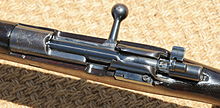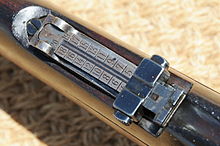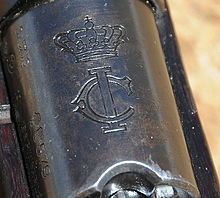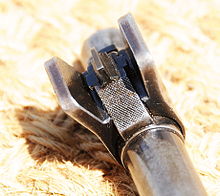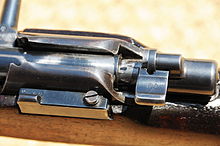- Mauser-Vergueiro
-
Mauser-Vergueiro Rifle 
Mauser-VergueiroType Bolt-action rifle Place of origin  Portugal
PortugalService history In service 1904–1939 Used by Portugal, Brazil, South Africa, German East Africa Wars World War I Production history Designer José A. Vergueiro Designed 1904 Produced 1904–1945 Variants Rifle m/1904, Carbine m/1904 and Rifle m/1904/39 Specifications Weight 3.9 kg (Rifles m/1904 and m/1904/39)
3.6 kg (Carbine m/1904)Length 1,110 mm (Rifles m/1904 and m/1904/39)
1100 mm (Carbine m/1904)Barrel length 600 mm (23.6 in) Cartridge 6.5×58mm Vergueiro (Rifle and Carbine m/1904)
7×57mm Mauser (Rifle m/1904, export model)
7.92×57mm Mauser (Rifle m/1904/39)Action Bolt-action Muzzle velocity 715 m/s (2,346 ft/s) Feed system 5-round stripper clip, internal magazine Sights Iron sights adjustable out to 2000 meters Mauser-Vergueiro was a bolt action rifle, designed in 1904 by José A. Vergueiro, an infantry officer of the Portuguese Army. It was developed from the Mauser 98 rifle with the introduction of a new bolt system. Outside Portugal, the weapon was also known as the Portuguese Mauser. It used the 6.5x58mm Vergueiro, a cartridge developed specially for it.
The weapon replaced the Kropatschek m/1886 as the standard infantry rifle of the Portuguese Army in 1904, remaining in service until it was replaced by the Mauser 98k in 1939. In Portuguese service the weapon was officially designated Espingarda 6,5 mm m/1904 ("Rifle 6.5mm m/1904"). A lighter and shorter version of the weapon was classified as a carbine and designated Carabina 6,5 mm m/1904. The Mauser-Vergueiro was also in the service of Brazil and South Africa, chambered in 7x57mm Mauser.
In Portuguese and South African service it was used in combat in the First World War and in several colonial campaigns. The German colonial troops in East Africa also used Mauser-Vergueiro rifles, captured from the allied forces in combat, preferring them to its proper Mauser rifles of German origin.
The Portuguese troops serving with the Portuguese Expeditionary Corps on the Western Front did not use the rifle but the Lee-Enfield (m/917) instead; to avoid logistical issues.
In 1939, after the Portuguese Army had adopted the 7.92x57mm Mauser 98k as the m/937, many of the remaining Mauser-Vergueiro rifles were modified to chamber the new standard cartridge. The modified rifles were called Espingarda 8 mm m/1904/39.
Categories:- Bolt-action rifles
- World War I Portuguese infantry weapons
Wikimedia Foundation. 2010.



